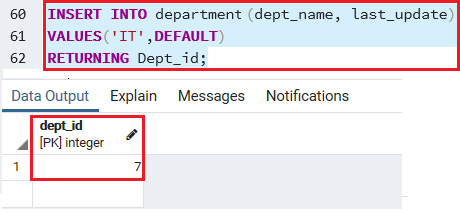
#POSTGRESQL INSERT UPDATE#
This means you can use a trigger to modify the values to be inserted into a new row or used to update a row. In a BEFORE trigger, you can also change its value with SET NEW.col_name = value if you have the UPDATE privilege for it. You can refer to a column named with NEW if you have the SELECT privilege for it. You can refer to it (if you have the SELECT privilege), but not modify it. In a DELETE trigger, only OLD.col_name can be used there is no new row.Ī column named with OLD is read only.In a UPDATE trigger, you can use OLD.col_name to refer to the columns of a row before it is updated and NEW.col_name to refer to the columns of the row after it is updated.In an INSERT trigger, only NEW.col_name can be used.Within the trigger body, the OLD and NEW keywords enable you to access columns in the rows affected by a trigger.There are two PostgreSQL extensions to trigger ' OLD' and ' NEW'. In the above trigger function there is new keyword ' NEW' which is a PostgreSQL extension to triggers. Now we can create the trigger which will fire at the time of execution the event as specified in the trigger for the associated tables. Here is a simple example of trigger function.: The following table summarizes which types of triggers may be used on tables and views: In addition, triggers may be defined to fire for TRUNCATE, though only FOR EACH STATEMENT. BEFORE and AFTER triggers on a view must be marked as FOR EACH STATEMENT. Triggers that are specified to fire INSTEAD OF the trigger event must be marked FOR EACH ROW, and can only be defined on views. The arguments are literal string constants. If neither is specified, FOR EACH STATEMENT is the default.Ī Boolean expression that determines whether the trigger function will actually be executed.Ī user-supplied function that is declared as taking no arguments and returning type trigger, which is executed when the trigger fires.Īn optional comma-separated list of arguments to be provided to the function when the trigger is executed. Specifies whether the trigger procedure should be fired once for every row affected by the trigger event, or just once per SQL statement. This can only be specified for constraint triggers. This option is used for foreign-key constraints and is not recommended for general use. The (possibly schema-qualified) name of another table referenced by the constraint. The name of the table or view the trigger is for. One of INSERT, UPDATE, DELETE, or TRUNCATE, that will fire the trigger. A constraint trigger can only be specified as AFTER. The name cannot be schema-qualified - the trigger inherits the schema of its table.ĭetermines whether the function is called before, after, or instead of the event. A trigger must be distinct from the name of any other trigger for the same table. Syntax: CREATE TRIGGER name ]ĮXECUTE PROCEDURE function_name ( arguments ) The statement CREATE TRIGGER creates a new trigger in PostgreSQL. an insert, update or delete) occurs for the table/views.

It supports the declaration of local variables, statements to control the flow of the procedure, assignment of expression results to variables, and error handling.Ī trigger is a named database object that is associated with a table, and it activates when a particular event (e.g. It supports constructs that are common to most programming languages. Implementation of SQL triggers is based on the SQL standard. All rules run on the server before the result returns. Improve performance in client/server environment.If a business policy changes, you need to change only the corresponding trigger program instead of each application program. Define a trigger once and then reuse it for any application that uses the database.
#POSTGRESQL INSERT CODE#
Because the database stores triggers, you do not have to code the trigger actions into each database application. Replicate data to different files to achieve data consistency.Query from other files for cross-referencing purposes.Write to other files for audit trail purposes.Generate a unique value for a newly-inserted row in a different file.PostgreSQL Trigger : Example AFTER DELETE.PostgreSQL Trigger : Example BEFORE UPDATE.PostgreSQL Trigger : Example AFTER UPDATE.PostgreSQL Trigger : Example BEFORE INSERT.PostgreSQL Trigger : Example AFTER INSERT.



 0 kommentar(er)
0 kommentar(er)
